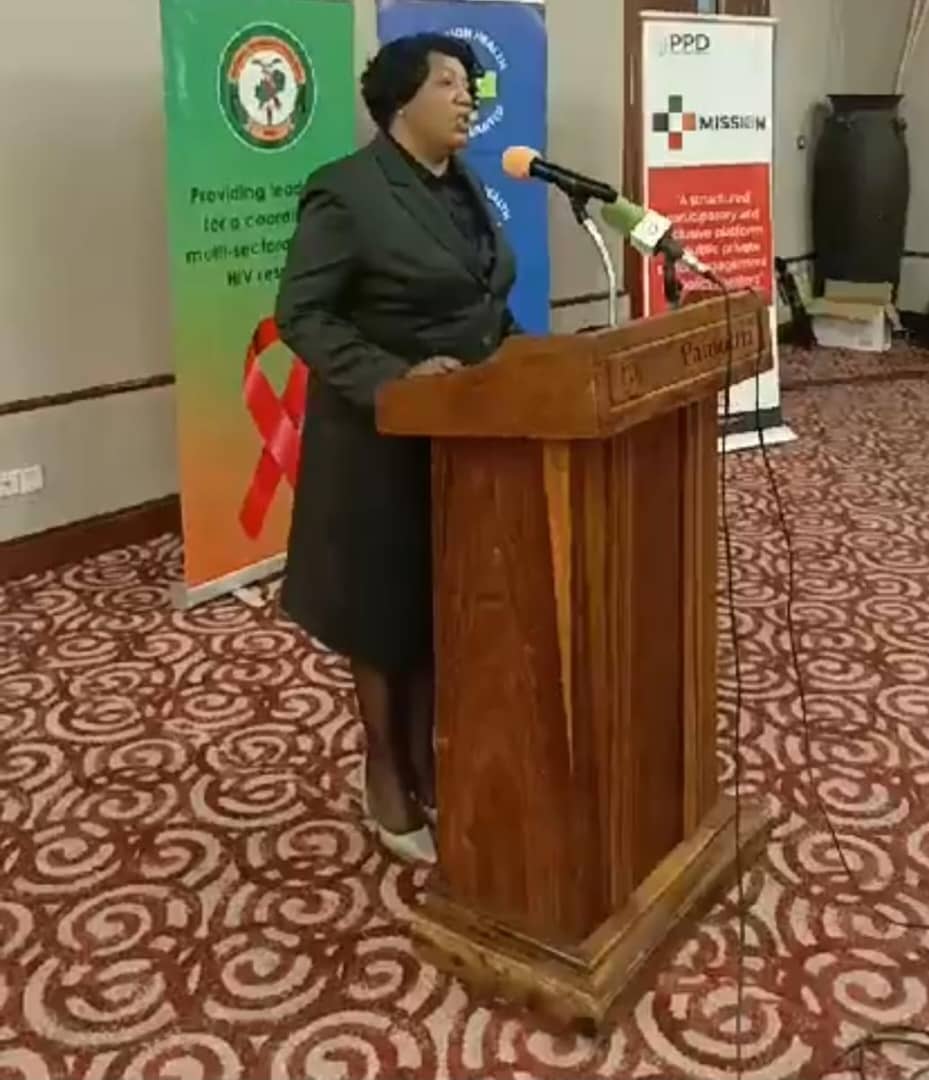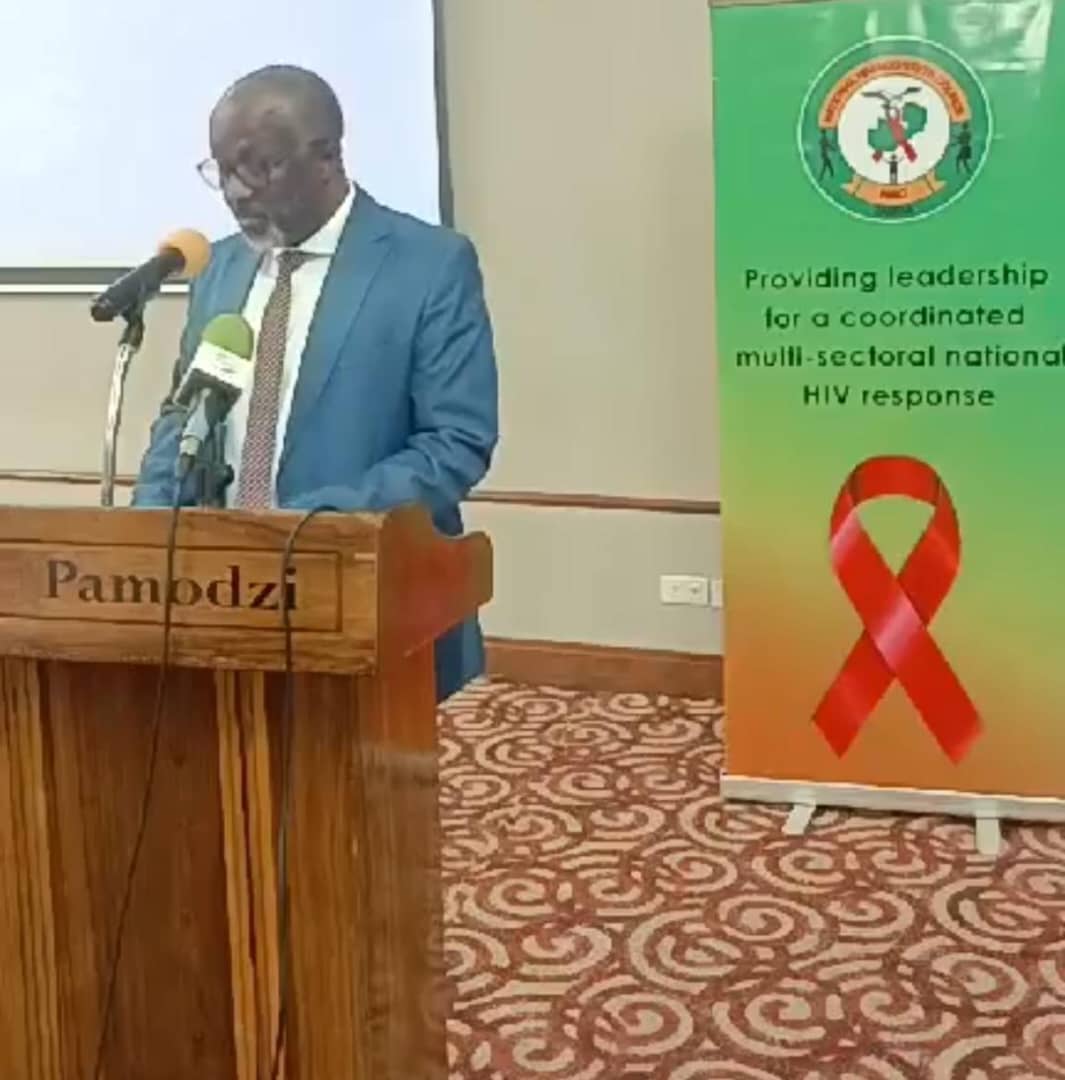HIV Gains, Challenges Ahead

The health authorities amd activists says While treatment targets are met, new infections, pediatric gaps, and TB co-infections persist.
By Francis Maingaila
Lusaka, Zambia, 24 Aug. 2025 – Zambia has made remarkable strides in its fight against HIV, surpassing key treatment targets, but health experts warn that high new infections, persistent pediatric gaps, and tuberculosis (TB)-HIV co-infections continue to pose serious challenges.
 Dr. Chimika Phiri, HIV Prevention Adviser at the Ministry of Health, detailed Zambia’s progress and ongoing challenges during a briefing in Lusaka.
Dr. Chimika Phiri, HIV Prevention Adviser at the Ministry of Health, detailed Zambia’s progress and ongoing challenges during a briefing in Lusaka. “Zambia has achieved 98-98-97 in the UNAIDS 95-95-95 targets,” he said.
“This means nearly all people living with HIV know their status, almost all are on treatment, and nearly all on treatment have achieved viral suppression. This is a huge national milestone that reflects decades of effort by government, partners, and communities.”
Between 2016 and 2021, Zambia’s national HIV incidence fell from 0.6% to 0.3%, reflecting the success of treatment scale-up and improved viral suppression.
Certain provinces, including Southern and Lusaka, have performed above the national average, while others lag behind, emphasizing the need for tailored, location-specific interventions.
Dr. Phiri emphasized that reducing viral loads in people living with HIV is key to preventing further transmission.
“Evidence shows that those achieving undetectable viral loads cannot transmit HIV sexually, which accounts for over 95% of new infections,” he said.
Despite these gains, children remain the most vulnerable group. About 18% of HIV-positive children are yet to be identified and treated.
“This is a worrying gap because children represent the future of the country,” Dr. Phiri said.
“We need innovative strategies to find and treat these children to achieve epidemic control.”
Mother-to-child transmission remains a concern. Many women acquire HIV during pregnancy or breastfeeding, which can lead to new infant infections.
Health authorities are intensifying prevention efforts, ensuring mothers on treatment achieve viral suppression, which virtually eliminates the risk of transmission to newborns.
Zambia continues to record approximately 50,000 new HIV infections annually—well above the national goal of fewer than 15,000 by 2026. Provincial disparities remain significant.
While Western and Southern provinces report high treatment coverage, Copperbelt and other regions show large gaps, particularly among children.
Adolescents and young people also face barriers. HIV knowledge is often limited, and legal restrictions requiring parental consent for testing under age 16 hinder access to essential services.
Innovative Interventions

To close these gaps, Zambia has introduced several innovative interventions. The Ministry of Health revised the national minimum HIV service package to standardize care across facilities, ensuring consistent quality regardless of location.
Zambia is also part of the Global Alliance to 1End AIDS in Children, which aims to eliminate child deaths from AIDS by 2030.
In HIV prevention, Zambia has become one of the first countries globally to offer injectable PrEP outside research settings, providing protection every two months, with a six-month injectable planned for early 2026.

TB-HIV Co-infection Remains a Challenge
Dr. Phiri also highlighted tuberculosis (TB) as a continuing challenge. TB remains the leading cause of death in Zambia, surpassing HIV alone.
About 60,000 Zambians develop TB each year, with one-third co-infected with HIV. Drug-resistant TB affects an estimated 2,000 people, though detection remains limited.
Factors such as overcrowded housing, high urban population density, and cross-border movement contribute to TB spread, particularly along major transport corridors.
While treatment success rates exceed 90%, undetected cases threaten to undermine overall control efforts.
“While Zambia has achieved impressive milestones, sustained investment, innovation, and targeted prevention are critical,” Dr. Phiri said.
“We must scale up HIV prevention, close treatment gaps for children, strengthen TB-HIV integration, and ensure consistent funding. Only then can we achieve epidemic control by 2026 and move toward an HIV-free generation.”

Private Sector Engagement
The government has urged private sector stakeholders to support Zambia’s fight against HIV through collective action, workplace policies, and public education initiatives.
Dr. Lackson Kasonka, Permanent Secretary in charge of Special Duty, delivered a message on behalf of Minister of Commerce, Trade and Industry Chipoka Mulenga during a stakeholder meeting in Lusaka.
The Minister was unable to attend due to competing commitments.
Dr. Kasonka highlighted Zambia’s ongoing HIV challenges, noting that approximately 1.4 million people are living with HIV.
He emphasized that the government continues to provide resources while encouraging corporate partners to adopt workplace HIV policies.
“Information sharing, collaboration, and innovation are critical to ensuring our communities are informed and empowered,” Dr. Kasonka said, urging businesses to integrate HIV prevention into operations.
The meeting brought together representatives from UNAIDS, civil society, and private enterprises to discuss strategies for education, prevention, and workplace programs.

National AIDS Council Urges Private Sector Action
NAC Director General Kebby Musokotwane called on the private sector to sustain Zambia’s HIV response as foreign aid continues to decline.
Speaking at a high-level dialogue in Lusaka, Musokotwane warned that cuts in external funding put decades of progress at risk.
“This is not a temporary budget shortfall; it is a new and permanent reality,” he said.
“The survival of Zambia’s HIV program depends on stepped-up investment and innovation from the private sector.”
He stressed that a healthy workforce is critical for business productivity. “Investing in health is a direct investment in your company’s stability and bottom line,” Musokotwane said.
He urged companies to integrate HIV prevention, testing, and treatment into workplace wellness programs and corporate social responsibility initiatives.
Private sector expertise in supply chain management, data analytics, and communications is also needed to strengthen national HIV programs.
“This meeting is not about asking for handouts,” Musokotwane said.
“It is about forging a new partnership where government, donors, and businesses work together to sustain gains and build a resilient, Zambian-funded defense against HIV.”
Private Public Dialogue Forum Contributions
The PPDF has called on private sector leaders to increase their contribution to Zambia’s HIV response, warning that overreliance on external donors threatens sustainability.
PPD Director General Andrew Chipwende highlighted that private sector engagement is critical for improving community health.
He noted that companies currently reach over 10,000 clients through workplace programs that also support surrounding communities.
Chipwende described efforts to digitize HIV programs, aiming for full implementation by 2026. He also highlighted advisory programs for small and medium enterprises, including financing solutions to expand healthcare access.
Jacqueline Chishimba, Director of Communications and Strategic Partnerships at PPDF, noted that while the private sector contributes over 80% of Zambia’s GDP and employs 88% of the workforce, its direct support for HIV programs remains below 7%.
She emphasized the importance of integrating HIV services into workplace wellness, expanding insurance coverage to include HIV care, allocating at least 1% of CSR budgets to HIV programs, and scaling up local production of HIV commodities.
UNAIDS Perspective
UNAIDS Country Director Isaacs Ahemesah stressed the importance of public-private collaboration in ensuring universal access to medicines and treatment. He highlighted that President Hakainde Hichilema established the PPDF to ensure private sector input informs policy decisions.
“Policies developed without private sector consultation often face serious implementation challenges. The President’s vision is that Zambia’s economy should shift from being government-driven to one anchored in the private sector, with government playing a supportive role,” he said.
Mr. Ahemesah announced the creation of a Health Technical Working Group under PPDF to identify health system gaps and develop joint solutions with government.
An MOU formalizing this framework is under review by the Attorney General’s chambers.
“The PPDF is committed to facilitating collaboration so that every Zambian in need of critical medicines, including ARVs, can access them without impediments,” he said.
Sustaining Zambia’s Gains
NAC Director of Programs Katongo Silwizya reiterated that declining donor support threatens Zambia’s progress, warning that private sector participation is essential.
He called on businesses to integrate HIV services into workplace wellness programs, support local production of medical supplies, and contribute to the National HIV Response Fund.
“HIV is like a jigsaw puzzle—if one piece is missing, the whole picture falls apart,” Silwizya said.
“No business thrives in an unhealthy nation. The fight against HIV is not just for government and donors; it requires the private sector to stand up and take responsibility.”
Zambia’s HIV response now hinges on continued investment, innovation, and partnerships across government, civil society, and the private sector to ensure a sustainable, resilient, and HIV-free future.



Comments
Post a Comment